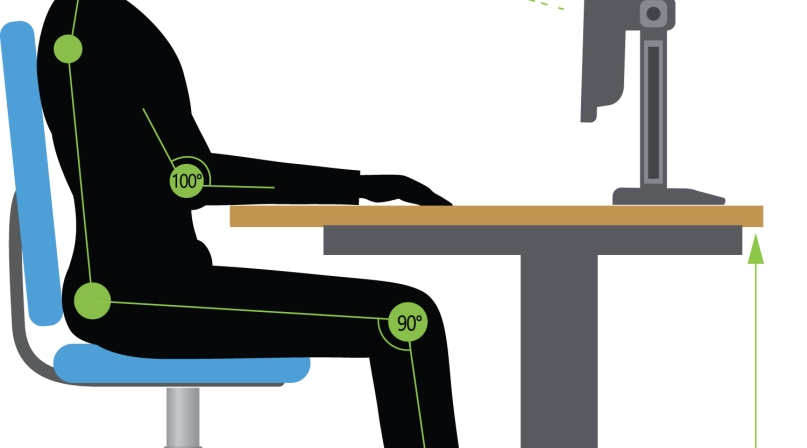First: ‘Tennis Elbow,’ Now ‘Text Neck’
Author

Erika Philpot

Rose Winkeler
Upcoming Events
Related News

Text neck, as defined by spine-health.com is “neck pain and damage sustained from looking down at your cell phone, tablet or other wireless devices too frequently and for too long.” You have seen it all around you — at a meeting break, in line at the grocery store, a pedestrian walking down the sidewalk or with kids in the backseat of a car — or you have known the feeling yourself. The whole world appears to have text neck, maybe not the pain, but certainly the angle of downward glance. (Why is it so awkward to raise our hands to eye level when we look at our phones or tablets?) But text neck, as it is now called, isn’t entirely new. As a Mount Whitney climber recently shared, text neck feels a lot like hiker’s neck. When you hike all day, constantly looking down at your feet looking for rocks and steps, the neck angle is very much the same. Also, avid readers will recognize the neck stretch that is text neck.
According to the 2018 Liberty Mutual Workplace Safety Index, serious, non-fatal workplace injuries cost U.S. businesses more $1 billion a week, or $60 billion a year, with repetitive motion involving microtasks accounting for $1.5 billion of the total.
The question, truly, is how can we improve not just text neck, but overall posture, particularly when we are seated?
According to a 2016 article by Business Insider, 86 percent of Americans sit all day at work. If this includes you, here are some ergonomic basics to assist in avoiding workplace injuries at your desk:
1. Adjust your chair
You just inherited an office chair that was likely adjusted for someone else. That former employee may have been four inches taller or shorter, than you are. As part of onboarding, block out 20 minutes to adjust the office chair. If you don’t know how, YouTube has resources on how to adjust an office chair. The office chair is one of the most important tools you use every day and has levers and knobs that adjust everything from height, position and tilt.
2. 90-degree angles
Proper posture says that your elbows, hips, knees and ankles should be at 90-degree angles when seated. Adjust a chair with a buddy, where you and your co-worker evaluate how you are each sitting at your desk. Tell one another if your elbows and knees are at 90-degree angles. Perhaps you take each other’s photo sitting at your desk, so you can see if your posture at your desk resembles the mental image you have in your mind.
3. Eyes even with the top of the monitor
Often employees think they should be looking at the middle of the screen for proper ergonomics, but the rule of thumb is actually for the top of the screen to be at eye level so the chin is level and the spine is straight.
4. Wrists neutral
Wrists should be neutral or level to the work surface with a padded wrist rest. The mouse should be close to the keyboard, maintaining the 90-degree elbow position.
5. Avoid twisting
Work chairs turn, swivel and have wheels so you can turn your chair rather than twist your body. (The wheels on the chair are not just to give a few inches of height when trying to reach an item on a high shelf — please don’t try this at home.)
Avoid the temptation to lean or twist for that heavy binder without moving the chair.
If you need the binder on a regular basis as a desk resource, consider moving it to a location of greater convenience, or use the need to access the binder as a reason to stand up and take a break from sitting.
6. Use a foot rest
Having a foot rest can result in better overall posture in addition to making sure your feet touch the floor.
7. Head tilt
Holding a phone, either desk phone or cell phone, with your shoulder can create neck strain. Often, in the past, desk phones had a cradle, but headsets, and speaker phone options are also available. If possible, use the phone call as an opportunity to change position, stand if you were seated, sit if you were standing.
8. Don’t forget the lighting
Having to squint, strain or get very close to the monitor is bad for your posture, and sometimes this is caused by improper lighting as much as by seated position. Glare from a window or light may be corrected by a slight adjustment to the monitor. If you have to wear a hat at your desk, this might indicate a less than ideal situation.
9. Help others
If you see an employee’s workstation with boxes, books and magazines under the keyboard, mouse or armrests, it is likely an indication that chair adjustments may be needed. It also may be preventing wrist neutral position.
10. Remember to stretch
Take several minutes every hour, maybe even while you are on the phone, to roll your wrists, roll your shoulders and extend your arms. Also, “stretch” your eyes by focusing on an object far away from you.
Need some ergonomics materials, but don’t have an ergonomics expert? Here are some fun and informational resources:
The Department of Environmental Health and Safety at the University of Pittsburgh has an Office Ergonomics Powerpoint available online at https://www.ehs.pitt.edu/assets/docs/OfficeErgonomics.pdf which may be helpful to share at an office staff meeting. The presentation covers a multitude of ergonomic topics including keyboard trays, mouse position, monitor height, phone use and lighting.
The University of California Performing Arts Safety Manual is a two-page safety guide developed by the Regents of California and is a great discussion starter on ergonomics, https://www.ucop.edu/environment-health-safety/_files/perform-arts/ergo.pdf. And of course, OSHA has an excellent resource on ergonomics, which may be found at https://www.osha.gov/SLTC/ergonomics/.
Lowering our shoulders and taking a minute to stretch can not only improve posture, and lessen workplace injuries, but also reduce stress.
So let’s all take a moment, inventory our posture, adjust all the knobs on our chair, and best use the office tools already provided. It is time well spent.
Attachments
Related News

Pa. counties consider furloughs, loans as state budget lapse continues
For the third time since 2015, an unresolved state budget dispute that has dragged on for several months has left counties without the revenue that they depend on to provide critical services.

County library cooks up interest with chef series
Orange County, Calif.'s library system drew in new patrons by introducing its offerings through a cooking video series.

County repurposes airport’s lost and found items for animal shelter
Broward County, Fla. staff made use out of items left behind at the county airport.